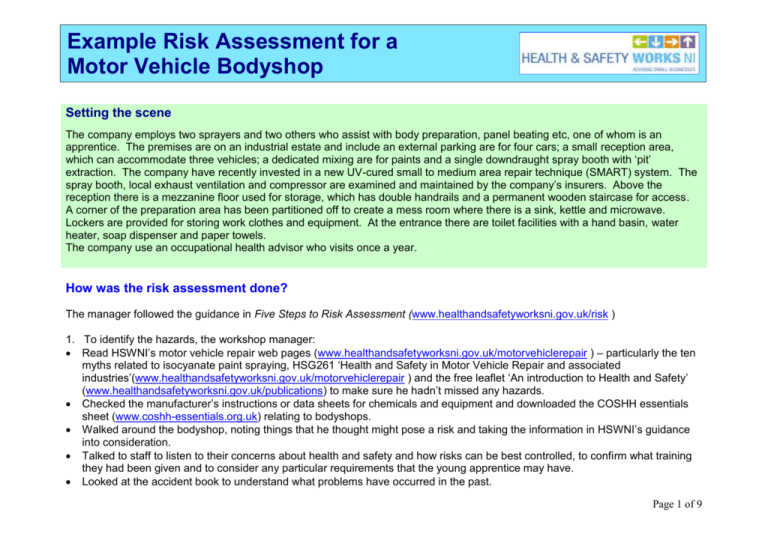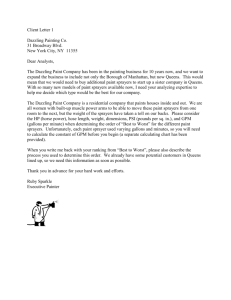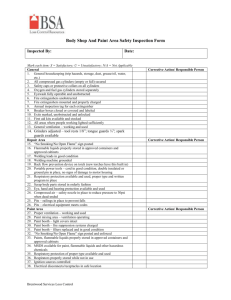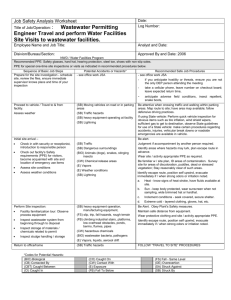Motor vehicle bodyshop - Health and Safety Works NI
advertisement

Example Risk Assessment for a Motor Vehicle Bodyshop Setting the scene The company employs two sprayers and two others who assist with body preparation, panel beating etc, one of whom is an apprentice. The premises are on an industrial estate and include an external parking are for four cars; a small reception area, which can accommodate three vehicles; a dedicated mixing are for paints and a single downdraught spray booth with ‘pit’ extraction. The company have recently invested in a new UV-cured small to medium area repair technique (SMART) system. The spray booth, local exhaust ventilation and compressor are examined and maintained by the company’s insurers. Above the reception there is a mezzanine floor used for storage, which has double handrails and a permanent wooden staircase for access. A corner of the preparation area has been partitioned off to create a mess room where there is a sink, kettle and microwave. Lockers are provided for storing work clothes and equipment. At the entrance there are toilet facilities with a hand basin, water heater, soap dispenser and paper towels. The company use an occupational health advisor who visits once a year. How was the risk assessment done? The manager followed the guidance in Five Steps to Risk Assessment (www.healthandsafetyworksni.gov.uk/risk ) 1. To identify the hazards, the workshop manager: Read HSWNI’s motor vehicle repair web pages (www.healthandsafetyworksni.gov.uk/motorvehiclerepair ) – particularly the ten myths related to isocyanate paint spraying, HSG261 ‘Health and Safety in Motor Vehicle Repair and associated industries’(www.healthandsafetyworksni.gov.uk/motorvehiclerepair ) and the free leaflet ‘An introduction to Health and Safety’ (www.healthandsafetyworksni.gov.uk/publications) to make sure he hadn’t missed any hazards. Checked the manufacturer’s instructions or data sheets for chemicals and equipment and downloaded the COSHH essentials sheet (www.coshh-essentials.org.uk) relating to bodyshops. Walked around the bodyshop, noting things that he thought might pose a risk and taking the information in HSWNI’s guidance into consideration. Talked to staff to listen to their concerns about health and safety and how risks can be best controlled, to confirm what training they had been given and to consider any particular requirements that the young apprentice may have. Looked at the accident book to understand what problems have occurred in the past. Page 1 of 9 2. The manager then wrote down who would be harmed by the hazards and how. 3. For each hazard identified, the manager recorded what controls, if any, were in place to manage these. He then compared these controls to the HSWNI guidance. Where existing controls did not meet good practice, the manager wrote down what further actions were needed to manage the risk. 4. The manager put the findings of the risk assessment into practice. He then decided and recorded who was responsible for implementing the further actions and when they should be done. When each action was completed it was ticked off and the date recorded. He made the risk assessment part of the induction process for new staff. 5. The findings of the risk assessment were discussed with the sprayers and other staff. The manager decided that a review and update of the risk assessment would be made annually or sooner if things changed. Important Reminder This example risk assessment shows what kind of approach a small business might take. Use it as a rough guide to think through some of the hazards in your business and the steps you need to take to control the risks. Please note that this is not a generic risk assessment that you can just put your company name on and adopt wholesale without any thought. This would not satisfy the law – and would not be effective in protecting people. Every business is different – you need to think through the hazards and controls required in your business for yourself. Page 2 of 9 Example Risk Assessment for a Motor Vehicle Bodyshop What are the hazards? Company name: Hope and Spray Bodyshop Date assessment was carried out: 01st Oct 2010 Date of next review: 01st Oct 2011 Assessment carried out by: Manager Who might be harmed and how? Hazardous substances Contact with body-fillers, glues, paint thinners and paint. Skin contact can lead to workers getting dermatitis. Inhalation of paint mist containing isocyanate Workers and any visitors breathing in the mist may develop asthma. What further action do you need to take? What are you already doing? Who needs to carry out the action? When is the action needed by? Done Low-protein powder-free latex gloves supplied and used. Disposable overalls supplied/used. Overalls replaced as required. Risks from dermatitis explained to workers and workers trained to spot (and report) any early signs of dermatitis, ie dry, red, itchy skin. Manager to check that gloves are being used. Manager 08/10/10 Manager to arrange with OHP Each October or if new employee taken on All spraying carried out in spray booth. Workers trained in safe use of equipment and safe systems of work. Equipment regularly maintained by a competent person and manager checks this is done and record results. Only those with air-fed masks allowed in booth. Air-fed masks used by all sprayers and kept in place during ‘clearance time’ (measured at 1 min 15 sec and marked on outside of booth. As no history of dermatitis at company, occupational health advisor (OHP) suggested that annual skin check sufficient with skin checks on all new employees. Show sprayers video clips from HSE MVR website showing how they can be exposed to invisible paint mist. Manager 30/11/10 28/11/10 Manager check that air-fed masks are used correctly and sprayers don’t flip up visor until after the clearance time. Manager Random Note on computer calendar Page 3 of 9 08/10/10 What are the hazards? Inhalation of paint mist containing isocyanate (continued) Who might be harmed and how? ----- What further action do you need to take? What are you already doing? Spray booth checked to manufacturer’s instructions and tested and examined every year by insurers. Breathing air quality from compressor checked every 3 months by insurers. Air inlet for compressor well clear of any contaminants. Spray guns cleaned in ventilated gun cleaner – spray-to-dry in booth wearing airfed mask. Sanding/grinding produce large quantities of dust that can damage worker’s lungs. Exposure to UV in UVcured SMART paint system and arc welding UV can damage unprotected eyes and skin of workers causing ‘arc eye’, cataracts and long term skin cancer. When is the action needed by? Done Booth automatic overpressure shut down checked every quarter. Sprayer Start 01/11/10 Chart fixed to booth Biological monitoring (urine tests) and breathing checks (health surveillance) arranged annually for sprayers with occupational health provider to check that controls are working properly and whether there are early signs of asthma. Breathing checks to be carried out on all new employees. Arrange for examination and testing of extraction equipment every year by insurance company (tie in with booth testing if possible). Explain to sprayers that some precautions taken against inhalation of paint mist as for isocyanates. Manager to arrange with OHP Each Oct or if new employee taken on Copies of Health records stored safely Manager to arrange with insurers 31/01/12 Records kept in office Inhalation of dust from sanding and grinding operations Who needs to carry out the action? On-tool extraction used for power sanding and grinding. Disposable dust masks available for hand sanding. Overall, gloves and supplied face shield used. Training provided by supplier. Welding-type screen encloses operation to protect others. Manager makes random checks Note on computer calendar Page 4 of 9 What are the hazards? Fumes from welding and flame cutting Fire General Fuel Who might be harmed and how? Workers may suffer harm, eg to lungs, from harmful fumes and gases generated during welding including from primer, paint layers, underseal, etc. Workers/others may suffer serious or fatal injuries from burns and/or smoke inhalation if trapped. Workers could suffer severe or fatal burns if petrol gets on them and is ignited. Paint and thinners Paint thinners are highly flammable (as for petrol) and paint mist can cause fire or explosions. What further action do you need to take? What are you already doing? Who needs to carry out the action? Check with manufacturer whether further precautions required for ultra highstrength steels. Fire risk assessment undertaken as required by law, see www.fire.gov.uk/workplace+safety Continue to ensure that Manager actions identified as necessary by the fire risk assessment are carried out. Fuel tanks reasonably empty (preferably around a quarter full) and fuel cap removed before baking. Proprietary fuel-retriever used in open air Hot work in any fuel tank prohibited unless inerted. LPG fuelled vehicles subcontracted to specialist refinisher. Less than 50 litres of solvent kept in metal bin inside workshop. Larger quantities kept in the locked and ventilated fire-resisting store in the yard. Paint mixing unit is fire-resistant and well ventilated. All electrical equipment within 1 m of mixer is correctly ex rated. Metal bin with tight fitting lid used for waste rags Only ex rated equipment allowed in spray booth. No hot works or sparks near fuel or solvent. Mobile extraction unit with sufficiently long flexible trunking used. Extraction system maintained and tested annually. Manager Provide employees with Manager info from INDG331 Safe use of petrol in garages, Vehicle Finishing Units – Risks from Gross Leakage of fuels and INDG314 Hot work on small tanks and drums. Manager to speak to Manager disposal company When is the action needed by? Done 31/10/10 28/10/10 31/10/10 28/10/10 29/12/10 29/12/10 Page 5 of 9 What are the hazards? Noise Who might be harmed and how? Staff and others may suffer hearing damage from exposure to noise from pneumatic tools and metal cutting equipment, eg angle grinder. Vibration Electrical Workers may suffer vibration white finger (hand-arm vibration – HAV) from over use of power tools (eg sanders, grinders and disc cutters). Staff could get electrical shocks or burns from using faulty electrical equipment or a faulty installation. Electrical faults can also cause fires. What further action do you need to take? What are you already doing? Purchasing policy to replace tools with quietest option. Noisy work restricted to ‘ear protection zone’ to reduce the numbers at risk. Suitable hearing protectors provided for staff and staff trained how to use, check and maintain them according to advice given by supplier. Staff trained in risk of noise exposure. Purchasing policy to have tools that have been designed and constructed to reduce the risk of vibration and are suitable for their intended use. Workers trained to use them safely and keep them properly maintained. Low-voltage hand lamps (240) used. Residual current device (RCD) built into main switchboard. Staff trained to spot and report any defective plugs, damaged cables or discoloured sockets to manager. Annual testing on all portable 240 v tools. Installation regularly maintained to a planned schedule. Who needs to carry out the action? When is the action needed by? Manager Workers to be shown HSWNI’s Noise webpages (www.healthandsafetyw orksni.gov.uk/noise ). Manager Seek opinion of OHP whether Health checks required. 31/10/10 Manager Workers who use vibrating tools to be shown HSE’s Vibration webpages (www.hse.gov.uk/vibrati on/hav/index.htm) 31/10/10 Seek the opinion of OHP whether health checks required. Manager to assess suitability of replacing 240 v tools with airpowered or 110 v alternatives June 2011 Manager June 2011 Manager 31/03/11 Page 6 of 9 Done 28/10/10 June 2011 31/10/10 June 2011 What are the hazards? Machinery Eg grinding equipment Failure of car lift or car jack. Who might be harmed and how? What further action do you need to take? What are you already doing? Workers might suffer trap or cut injuries from contact with moving parts or burn injuries. Also, particles can be ejected into the eyes. Workers may suffer severe crush injuries from falling vehicle if a car lift or jack fails. Compressed air Explosion of equipment, eg tyres Injection of air in the body. Staff could suffer blast injuries if the air receiver exploded or internal damage if compressed air is introduced into the body. Manual handling In the store, movement of components All employees could suffer from back pain if regularly lifting/carrying heavy or awkward objects. Pre –use checks on all mechanical equipment, faults reported to manager. Equipment not left running unattended. Equipment guarded to manufacturer’s standards. Safety goggles provided and worn. Only trained persons use/change grinding wheels. Car lifts/jacks serviced by supplier and examined every 6 months by insurers. Axle stands maintained and inspected and damaged stands taken out of use. Axle stands used after lifting vehicle with jack. Safe working loads not exceeded. No further action required. No further action required. All employees trained in safe working procedures and dangers of horseplay. Air line has deadman’s handle. System serviced every year and thoroughly examined by insurers in accordance to the written scheme. No further action required. Staff instructed to use porter’s trolley to move heavier materials, parts etc. OHP to discuss manual handling techniques with staff. Manager to check that workers know how to lift safely and handle tyres in accordance with Collection and delivery of tyres. Who needs to carry out the action? When is the action needed by? Page 7 of 9 Done What are the hazards? Handling vehicle air bags Who might be harmed and how? Air bags could explode when not fitted causing injury to workers. What further action do you need to take? What are you already doing? Who needs to carry out the action? Pin up poster INDG280 Manager A guide to handling and storage of airbags and seatbelt pretensioners at garages and MVR shops in mess room. 31/10/10 25/10/10 31/10/10 27/10/10 Workers might be asphyxiated by gas release in confined space or get frostbite from skin or eye contact with refrigerant. Naked flame can cause refrigerant to decompose, creating harmful gases. Workers are trained in correct procedures. Manager Brief workers on safe systems of working with air conditioning systems (from HSE’s Safe working with Vehicle airconditioning systems INDG349). Vehicle movements Workers/others might suffer serious injury, eg fractures if struck by a vehicle (including being struck by a vehicle parked unbraked and/or unchecked and in gear, and then started up from outside the vehicle). Manager to monitor speed of cars in/out and around premises. Workers/others may suffer bruising or fractures from slipping on spills. Safe parking provided for customers. Marked walkways for pedestrians. Vehicles driven slowly in/out and around premises. Parked vehicles are braked or chocked when on vehicle lifts, jacks or axle stands or sloping ground. Engines always started and run with brakes on and in neutral gear, and by someone sitting in driver’s seat. Generally good housekeeping standards maintained. Staff ‘clean as they go’ eg clear up spillages immediately. Weekly housekeeping check to be started. Slips and trips Done Units stored in their own suitable cabinet. Workers trained in correct handling and fitting. Faulty units returned to supplier for disposal. Work involving air conditioning systems When is the action needed by? Page 8 of 9 What are the hazards? Falls from height Public access to workshop Who might be harmed and how? What further action do you need to take? What are you already doing? Workers might get injuries such as fractures if they fall from steps/ladders, top of vehicles, etc. Customers might be injured if they enter the workshop. Handrails fitted at edges of raised storage areas and access stairway provided. Employees trained to use steps/ladders safely. Manager to monitor use of portable steps/ladders, access equipment when working on vehicles. Signs up banning customers from the workshop, viewing window provided in reception. If customers need to enter workshop they must be escorted by a staff member. Staff to be reminded to challenge anyone entering the workshop without permission. Who needs to carry out the action? When is the action needed by? Random Assessment Review Date: 01/10/2011 Example risk assessment for a motor vehicle bodyshop, published by HSWNI, 10/10. Health and Safety Executive gratefully acknowledged as source. Page 9 of 9 Done Note on computer calendar


![[Agency] recognizes the hazards of lead](http://s3.studylib.net/store/data/007301017_1-adfa0391c2b089b3fd379ee34c4ce940-300x300.png)






